What’s it like visiting Spaceport America? The last time I visited the site, in 2009, it was under construction. Rough, back-country dirt roads with cryptic “A”-designator names extended across the ominously-named Jornada del Muerto, a name that I like translating as, “The Journey of Death,” especially after a cattle guard ripped the plastic liner from my car’s underbody. The name comes from an unfortunate German merchant who, fleeing from the Mexican Inquisition, succumbed to the elements in 1670. Somehow, ranchers manage to raise cattle in this treeless, waterless, desert wasteland. One of the few changes made to the region since 2009 is the paved road extending from the little town of Engle, south to County Road AO39. Another road extending north from Exit 32 on I-25 was initially supposed to be paved by Spring 2009, but remains a rough, gravel road at least into 2017. My photos in 2009 of the Spaceport America property mostly show earth-moving equipment scraping bare dirt lanes across the searing, scrub-covered countryside.

Building Spaceport America’s Main Entrance
If you ask the Spaceport Authority how to get to Spaceport America, they will tell you to buy a bus tour ticket from the tour operator in the New Mexican town of Truth or Consequences (known as T or C to the locals). The Spaceport Authority does not allow casual visits to the Spaceport and the gated entrance is guarded by security, who check the identities of everyone entering the facility. I bought my $45 ticket online at the official Spaceport America web page, http://spaceportamerica.com/ , then drove across Texas and New Mexico to this little town on the Rio Grande.
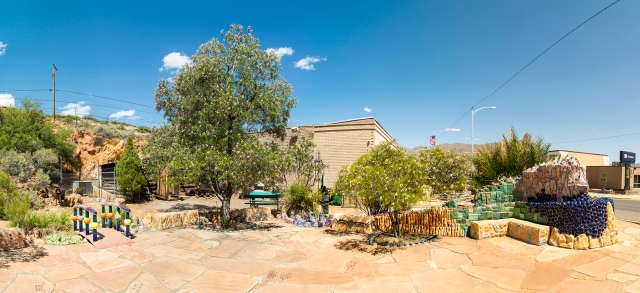
Geronimo Springs Park and Museum, Truth or Consequences, NM
Truth or Consequences is a quiet, remote town of about 6000 residents, situated in the southwestern portion of the State, along the steeply-rolling hills of New Mexico’s major river, the Rio Grande. Entrance to T or C comes via Interstate 25, which cuts through the middle of town. From its start in the late 19th Century, the area has made a living by offering visitors a relaxing place to recover from stress and illness. As in most parts of New Mexico, the buildings are of modest size and material. Most people live in small homes constructed of wood, adobe or brick. Up river on the North side of town the government completed what was then the second-largest irrigation dam in the world in 1916, forming Elephant Butte Reservoir. This makes T or C one of the few places in New Mexico where boating is practical.
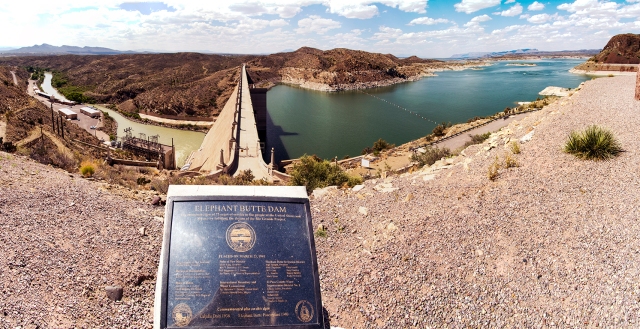
Elephant Butte Dam and Reservoir on the Rio Grande
After I entered town from the north, the main road curved gracefully toward downtown, just a few blocks from the tour office. The building at 301 South Foch Street is a modest, one-story adobe structure on the corner of the block that serves as a general visitor’s center for T or C. A large, red and white steel sign out front advertises the Spaceport America name. After entering the front entrance, I walked to the rear of the building, passing a few rooms occupied by visitor and tourism departments along the way. Spaceport America’s visitor center occupies a large room filling the rear half of the building.
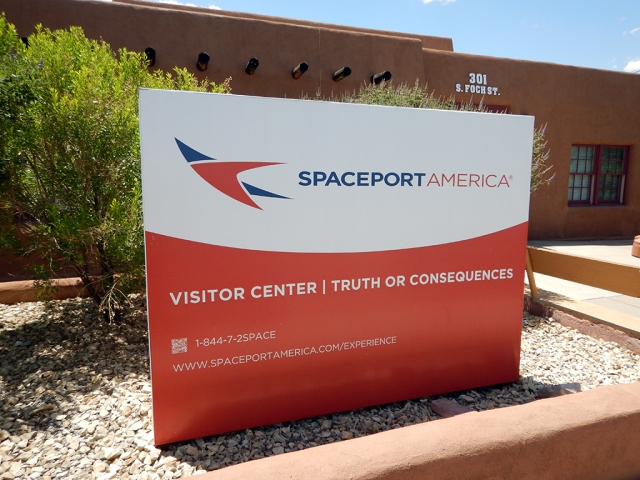
Spaceport America Visitor Center
“Do you have your boarding pass,” the tour operators asked the four of us standing at their desk. Only one of us did. “You have to have your boarding pass before you can board the bus” they informed us. We fished out our confirmation and identity documents and our guides handed us our boarding passes. Follow the Sun Inc. (FTS) handles these details, as they are the official tour operator for Spaceport America. Now properly documented, we found a seat aboard the twelve-passenger shuttle van, joining a few other passengers who were waiting for us. We had free access to bottles of water and packaged snack crackers.
As our shuttle pulled away from the visitor’s center, a man named Mark introduced himself as our tour guide. He pointed out the Ted Turner-owned Sierra Grande Lodge & Spa diagonally across the street from the visitor’s center. It will serve as pre-launch quarters for astronauts who purchase flights aboard Virgin Galactic’s spaceplanes. Further up the street, our guide highlighted some of the famous and historic hot spring bath houses that used to bring crowds of tourists a century ago. T or C hot springs are unique because they have high levels of lithium in the water but no sulfur. These warm waters are so close to the surface that simply digging a few feet in the gravel river beds produces pools of relaxing, warm water. A one-hour soak at Charles Motel and Spa is only five dollars. Follow The Sun Inc. earns money promoting tourism in the town, you see.
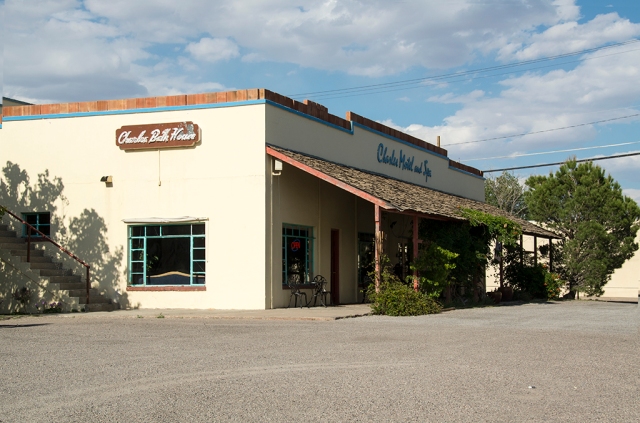
Charles Bath House and Spa
For a half-hour, we drove up the winding two-lane road out of the hills along the Rio Grande, until we reached the cluster of buildings that comprise the village of Engle. From there, we made a right-angle turn at the railroad tracks and shot South on Highway 51. The terrain widened to a plain speckled with gentle hills. We continued about another fifteen minutes until we reached Spaceport America, about as far out in the middle of nowhere as one can go in New Mexico. Thanks to the proximity of White Sands Missile Range, this area boasts a total of 6,000 square miles of restricted airspace. About half of that air space is over the Missile Range, located just over the San Andres Mountains to the East. No aircraft can fly overhead, leaving a wide-open window for anyone who just wants to take a quick trip 100 kilometers straight up and back down again.
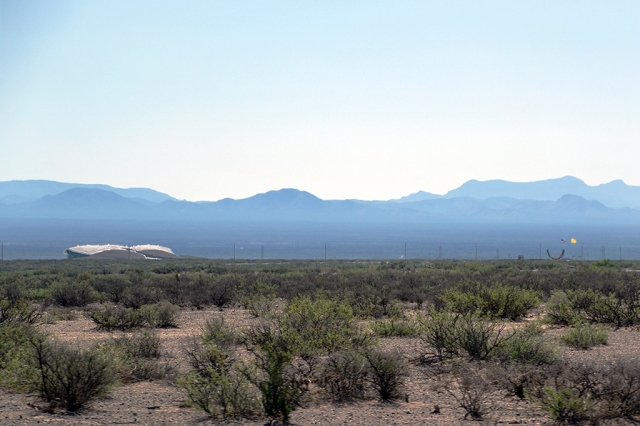
Looking East Towards Spaceport America
Interest in building a spaceport in New Mexico extends over 25 years to 1990. Initially, the plan was for New Mexico to provide a place for re-entry vehicles to land. As New Mexico is landlocked, orbital launches are a tougher sell. The FAA takes a dim view of an industry that drops tons of metal from the sky over populated areas soon after take-off. Then came new concepts in rocket launches. Lockheed Martin wanted to test its VentureStar rocket at a commercial spaceport, instead of in a government launch facility. However, the most exciting development was a new type of reusable rocket, a Single-Stage-to-Orbit (SSTO).
Long before most people had heard of Richard Branson, Elon Musk or Jeff Bezos, the success and promise of the “Delta Clipper” SSTO program (1991-1996) attracted great interest nationwide. Built by McDonnell Douglas and initially operated by the United States Department of Defense‘s Strategic Defense Initiative Organization (SDIO) before they handed it to NASA, SSTO promised the ability of placing payloads in orbit for $500 a kilogram and flight on demand, with a 24-hour turnaround between launches of the same rocket. Musk and Bezos champion reusable rockets to save costs, but Delta Clipper went beyond that concept, adding single-stage-to-orbit and advanced automation that kept support crew size to fifteen people. New Mexico, with so many state and federal high tech research labs, scientific and engineering personnel and unpopulated spaces—and that large missile range—was a strong contender among many states for winning federal funding for their spaceport.
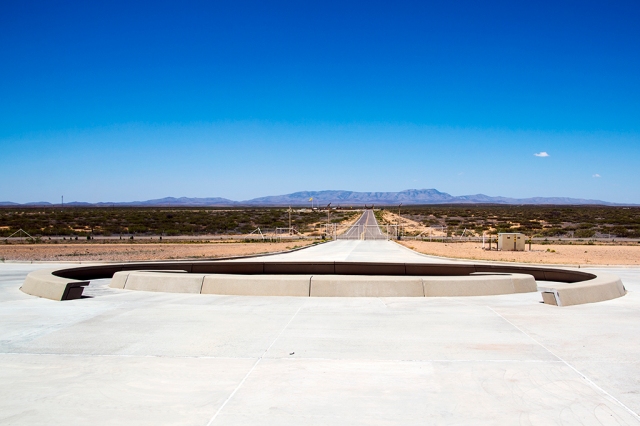
View West from Spaceport America’s Gateway to Space
NASA canceled the SSTO project in 1996 in favor of VentureStar only then to cancel VentureStar in 2001. Despite this setback, New Mexican officials, encouraged by their competition results for hosting the VentureStar project, pressed on with their vision for a spaceport within their state. The New Mexico Spaceport Authority was founded in 2005, and succeeded later that year in landing Sir Richard Branson’s Virgin Galactic as the first tenant of the yet-to-be-built spaceport. This ultimately opened the door to $219 million in funding for construction of the facility. Jerry Larson’s UP Aerospace began launching sounding rockets from Spaceport America property in 2006. Armadillo Aerospace conducted launches of its various experimental rockets. Lockheed Martin also conducted tests at the Spaceport. Other tenants were expected to arrive soon after construction finished in 2012. Jeff Bezos’ Blue Origin reportedly planned to rent space, and Elon Musk’s SpaceX signed an agreement. Seemingly, the stars had aligned for an exciting new era of space launches providing “airport-like” accessibility.
Then, the moment passed. The trigger for much of these developments had been the 2004 Ansari X Prize and the subsequent annual X Prize Cup, but the Cup was discontinued after 2007. Virgin Galactic’s spaceplane development has taken longer than expected, particularly after the catastrophic loss of their first test vehicle and a pilot in 2014. Bezos reportedly was displeased that his company’s as-yet unannounced plans were publicized as promotional material for the Spaceport, an affront to his expectations of privacy. He moved his operations to a plot of desert in West Texas where he could operate in secrecy. SpaceX continues renting space at Spaceport America but most of their testing is in McGregor, Texas, and most of their launches are in Florida. It is building its own spaceport at the southern tip of Texas. UP Aerospace continues launching from Spaceport America, but conduct only about two unmanned sounding rocket launches a year, down from the thirty a year it had hoped to reach. Armadillo Aerospace went into hibernation in 2013 and transferred their assets to Exos Aerospace Inc. in 2015, a consequence of founder John Carmack’s appointment as CTO of Facebook’s Oculus VR. Other promising “New Space” companies either did not sign lease agreements, or actually went out of business. So, today, Spaceport America is a pretty quiet place. Less than a dozen people work on the 18,000 acre site on a regular basis, substantially down from the projected hundreds.
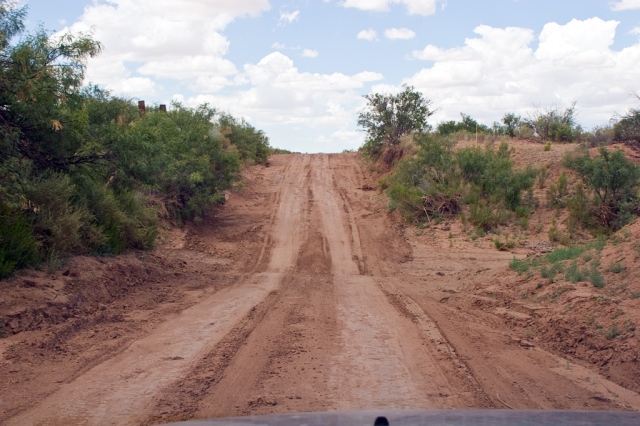
Roads like this make accessing Spaceport America from the South difficult
Spaceport America currently consists of the visitor’s center in Truth or Consequences, temporary office space in a small shopping center in Las Cruces that will be moved to the main facility after the southern road is paved, and the main facility near the ghost town of Upham. At the main facility, personnel work in two buildings: a 14,000 square foot two-story domed operations building that houses operations offices, the flight tower, and the fire department; or the 110,000 square-foot Virgin Galactic “Gateway to Space,” a three-story, LEED Gold-certified terminal hangar building that includes friends-and-family terminal space, mission control, astronaut training room and hanger space. Spaceport America spent $9 million for the design of a dedicated visitor’s center in T or C, but then they didn’t have enough money to buy land for the building, so its current visitor’s center shares office space with the Geronimo Trail National Scenic Byway Visitors Center in a former senior citizen’s center. After spending $220 million, New Mexico has a large, isolated, barricaded aerospace facility with state-of-the-art equipment and very few customers outside of a few government agencies and is losing $500,000 a year. Funny how that happened.
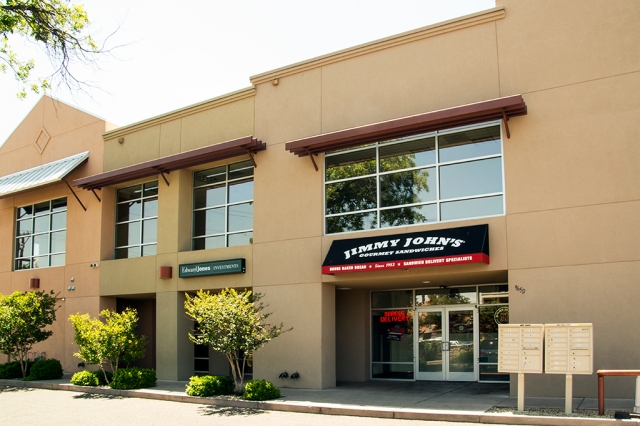
Temporary Spaceport America Administrative Offices
Eventually, I could see shapes in the distance on the left side of the road breaking the monotonous desert landscape, so I pulled out my cameras and began shooting. Soon, we came to a paved road to our left that was flanked by a pair of solar-powered street lights. About a mile down that road, I could see the buildings of Spaceport America. As we neared the far end of that road, we came to a large roundabout, about fifty feet in diameter, with a large, metal, crescent-shaped sculpture mounted in the middle, it’s ends upturned, like a pair of arms reaching for the sky. We drove around this sculpture without comment from our tour guide, and arrived at a pair of guard shacks. Our driver and tour guide swiped their badges on the badge reader and negotiated with the guard for a few minutes. Then, we drove past the guard shacks and onward to the Gateway to Space.
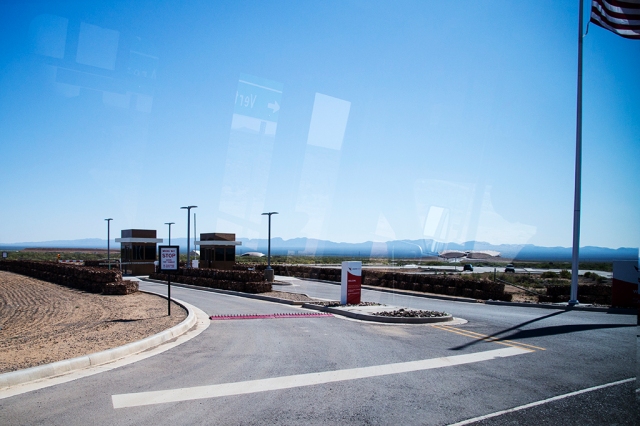
Spaceport America Front Gate
Our driver went into the building, leaving us sitting in front of the hanger, and our tour guide took over driving duties. As we slowly rode in front of the glass walls of the Gateway, he continued his tour guide patter, until we reached a spot halfway across the front of the building.
We got out and were given the opportunity to shoot photos. Mark said that he usually takes tour groups out to stand on the 12,000-foot long, 200-foot wide runway, but we have to get clearance before we could do that. After about ten minutes, we loaded back onto the van and rode around to the main entrance. We had a hundred-foot walk from the van to the door, where our driver was holding the combination-coded door open for us. By this point, we’ve already passed through the gate at the guard shack and another locked gate to get to this locked door.
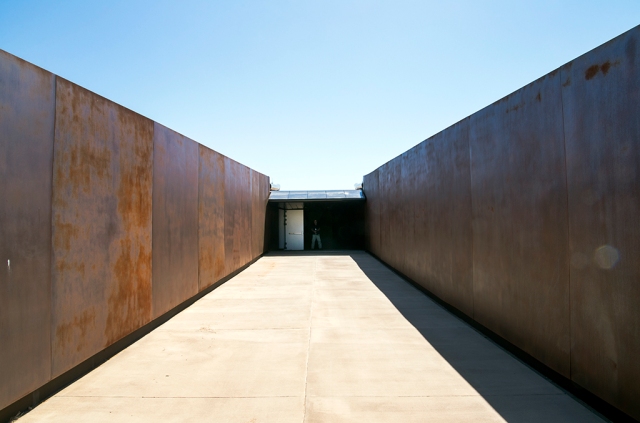
Visitor’s Entrance to the Gateway to Space
When we entered, we found ourselves in a short hall that opened into a large exhibit room. This is the Gateway Gallery. Displays along the nearest wall described significant events in rocketry and space exploration. Three panes of seven foot-tall windows across the room looked out on a hanger bay that was almost empty, save for a model of Virgin Galactic’s SpaceShipTwo. A gimballed, yellow metal cage with seats, called Gshock Centrifugal Trainer, occupied the middle of the room. Most of the rest of the room was filled with small restaurant tables and seats, but a small, darkened room within the room housed a glowing sphere, about two feet in diameter. Images of planetary surfaces or the Spaceport America logo alternately displayed on the sphere. Along an outside wall of this small room stood a series of electronic kiosks hosting games for children. Mark demonstrated the electronically-adjustable tinting of the windows.
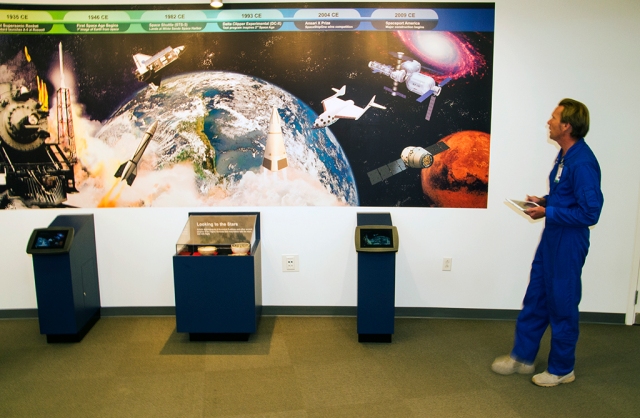
Aerospace History of Southern New Mexico
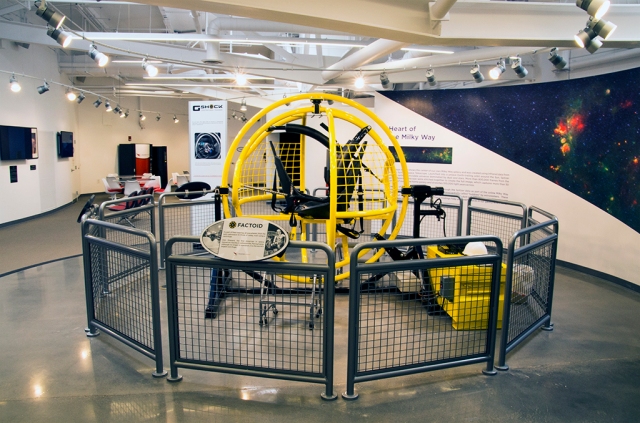
Middle of the Visitor’s Center
“Why not shutters?,” a visitor asked. The purpose of the tint is to control the view into the hanger bay. If someone in the hanger is working on confidential material, or a foreign visitor lacks security clearance, the Spaceport can opaque the windows. The electronic controls give a high-tech look that shutters might not.
During our twenty-minute rest in the visitor’s lounge, Mark gave pairs of us rides in the Gshock trainer. Then, we were left to contemplate our surroundings for several minutes. When the time came, Mark herded us back outside to the van.
Our next destination was the Operations Building. This domed building provides office space (much of which currently is empty) and houses the fire department. As we admired the empty offices visible through the glass walls of the lobby, we had a surprise impromptu Q&A with VP of Aerospace Operations Bill Gutman and Spaceport America CEO Christine Anderson (Anderson resigned her position in August 2016). Then, we were led through the building to the fire department’s vehicle bay, where we were given about a half-hour to chat with the fire fighters and examine and photograph their vehicles. The main pumper truck easily was the most interesting thing we saw on our trip. One of the members of our group asked a fire fighter if she could start the truck, so he showed us how to do it and let us listen to the engine roar.

Operations Building Houses Flight Control Tower and Fire Station
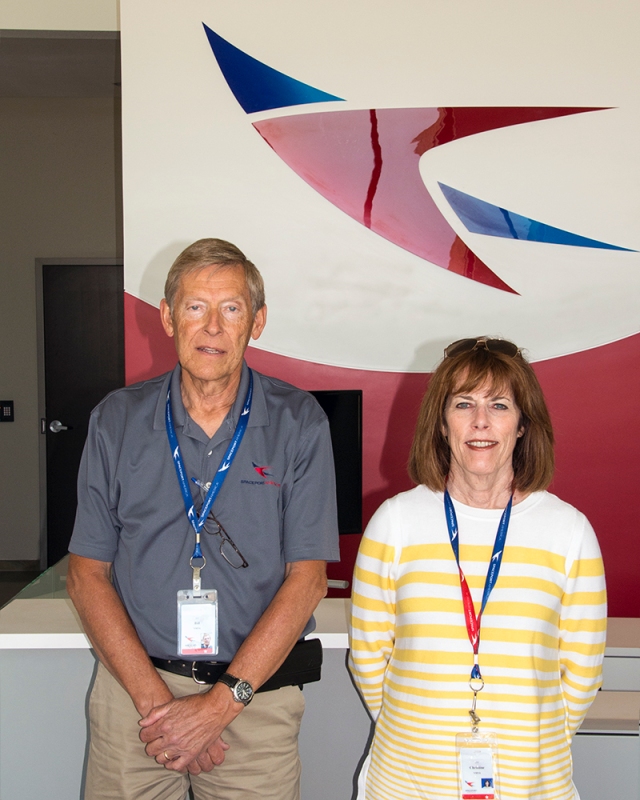
(L) VP of Aerospace Operations Bill Gutman and (R) Spaceport America CEO Christine Anderson
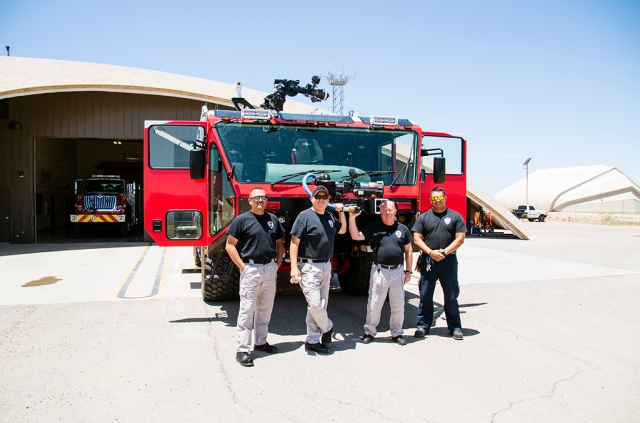
Spaceport America Fire Crew
After everyone loaded into the van, we made a stop to pick up our regular driver, then headed toward the front gate. Mark said that our trip to the runway had to be canceled, as secret Acme Company was out there conducting tests. We made one more stop for about fifteen minutes, to shoot photos of the sculpture in the roundabout. The sculpture by Otto Rigan, titled, “Genesis,” is 40-foot long by 5-foot wide steel with glass disk-shaped mirrors attached to its surface. We shot our photos, then returned to the van for our hour-long ride back to T or C.

“Genesis” Sculpture and Spaceport America Main Gate
I made this trip to document Spaceport America and how this investment by the citizens of New Mexico had turned out. I had asked for behind-the-scenes access, but my journalistic credentials as a freelance photojournalist and blog writer didn’t merit me much clout. We saw only a small part of the Gateway building, the Gateway Gallery. I commented to Christine Anderson that for a place striving for “airport-like” access, the Spaceport has a lot of restrictive security. For comparison, I could walk into Dallas Love Field Airport at any time and watch aircraft taking-off and landing all day, if I wished. Here, I have to schedule my visit ahead of time and pass through several locked access points. Anderson said that security at the Spaceport is about the same as at a commercial airport, and it is maintained to ensure the privacy of their clients. Such is the conflict between the Spaceport’s desire to be both a classified space-launch testing facility and a commercial spaceport.
Mark described one possible future commercial use for Spaceport America as a terminal for point-to-point global travel. For example, Aabar Investments, a United Arab Emirates (UAE)-owned private company, has a major investment in Virgin Galactic, a fact reflected by the name on the side of SpaceShipTwo. The rocket spaceplane would provide sub-orbital travel from Spaceport America to any place in the world, and UAE is expected to be the first destination. Right now, that seems a long way off, and getting longer all the time. However, as I sat in the van and thought about what I had seen that day, it seemed to me that even if all these commercial interests failed to amount to much, some government agency ought to find the facility useful. That is, if nearby Holloman Air Force Base and White Sands Missile Range weren’t sufficient. The direction of the industry makes me wonder if Spaceport America might be obsolete, that it might never be a practical commercial passenger facility.
Before I left T or C and continued on my way across New Mexico, I wandered around town, shooting photos and sizing up the place. Finally, I made one, last stop; a one-hour soak at Charles Motel and Spa.
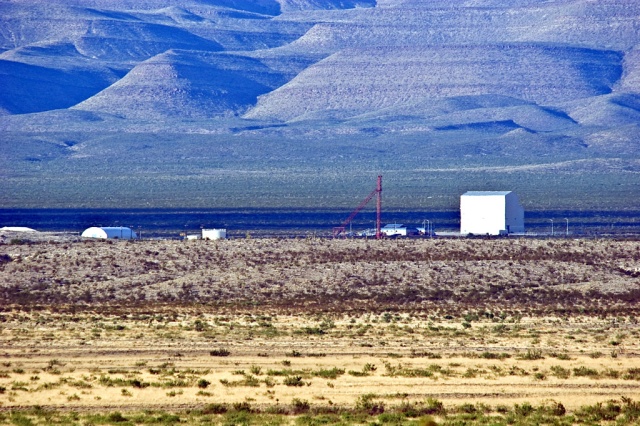
Bezos’ Blue Origin Operating in Complete Privacy in West Texas
Photos by Richard Alexander
All content Copyright Richard Alexander




